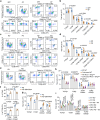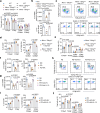Dietary nucleic acids promote oral tolerance through innate sensing pathways in mice
- PMID: 39487135
- PMCID: PMC11530426
- DOI: 10.1038/s41467-024-53814-0
Dietary nucleic acids promote oral tolerance through innate sensing pathways in mice
Abstract
Oral tolerance is essential for intestinal homeostasis and systemic immune function. However, our understanding of how oral tolerance is maintained is inadequate. Here we report that food-derived nucleic acids promote oral tolerance through innate sensing pathways. We find that dietary nucleic acids, but not microbiota, expand the natural intraepithelial lymphocyte (IEL) pool, specifically in the small intestine. TGF-β1, produced by natural IELs, then promotes activation of gut CD103+ dendritic cells to support the induction of antigen-specific Treg cells in a mouse model of OVA-induced oral tolerance. Mechanistically, MAVS and STING are redundantly required for sensing dietary RNAs and DNAs to activate downstream TBK1 signalling to induce IL-15 production, which results in the accumulation of natural IELs. Thus, our study demonstrates a key role of food-triggered innate sensing pathways in the maintenance of natural IELs and oral tolerance.
© 2024. The Author(s).
Conflict of interest statement
The authors declare no competing interests.
Figures







References
Publication types
MeSH terms
Substances
Associated data
LinkOut - more resources
Full Text Sources
Molecular Biology Databases
Research Materials
Miscellaneous

